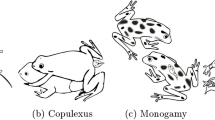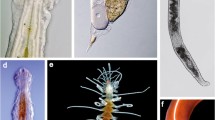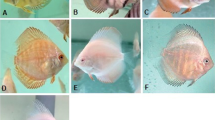Abstract
The detailed karyotypes of diploid (2n = 2x = 24) and triploid (2n = 3x = 36) of L. tigrinum were constructed based on fluorescence in situ hybridization (FISH) using 5S rDNA and 45S rDNA probes. The lengths of mitotic metaphase chromosomes ranged from 15.92 to 30.18 um, with a total length/genome of 250.46 um in diploid, and 15.24 to 28.16 um, with a total length/genome of 233.42 um in triploid. The chromosome composed of two pairs of metacentrics (Chromosomes 1 and 2), four pairs of subtelocentrics (Chromosomes 3, 4, 5, and 6) and six pairs of telocentrics (Chromosomes 7, 8, 9, 10, 11, and 12) in diploid L. tigrinum, two pairs of metacentrics (Chromosomes 1 and 2), six pairs of subtelocentrics (Chromosomes 3, 4, 5, 6, 7, and 11) and four pairs of telocentrics (Chromosomes 8, 9, 10, and 12) in triploid L. tigrinum. Ten (Chromosomes 1, 2, 6, 7, and 11) or twelve (Chromosomes 1, 2, 4, 6, 7, and 11) loci of 45S rDNA were detected in the diploid chromosomes whereas fifteen loci were detected in triploid chromosomes (Chromosomes 1, 2, 6, 7, and 11). Two loci of 5S rDNAs were located close to each other at the both diploid and triploid chromosome 3. New cytotypes of secondary constriction were observed in diploid (1-1-1-0) and triploid (3-2-1-1).
Similar content being viewed by others
Literature Cited
Chandler, C., W.M. Porterfield, and A. Stout. 1937. Microsporogenesis in diploid and triploid types of Lilium tigrinum with special references to abortions. Cytol. Fujii Jub. 2:756–784.
Comber, H.F. 1949. A new classification of the Lilium. Lily Year book, Royal Hort. Soc. London 15:86–105.
De Jong, P.C. 1974. Some notes on the evolution of lilies. Lily year book, North Am. Lily Soc. 27:23–28.
Harrison, G.E. and J.S. Heslop-Harrison. 1995. Centromeric repetitive DNA sequences in the genus Brassica. Theor. Appl. Genet. 90: 157–165.
Heslop-Harrison, J.S., T. Schwarzacher, K. Anamthawat-Jonsson, A.R. Leich, M. Shi, and I.J. Leich. 1991. In situ hybridization with automated chromosome denaturation. Technique 3:109–115.
Hsu-Siang, H. 1932. The structure of somatic chromosomes in Lilium tigrinum. La Cellule 41:163–173.
Ingle, J., J.N. Timmis, and J. Sinclair. 1975. The relationship between satellite deoxyribonucleic acid, ribosomal ribonucleic acid gene redundancy, and genome size in plants. Plant Physiol. 55:496–501.
Kim, J.H., H.Y. Kyung, Y.S. Choi, J.K. Lee, M. Hiramatsu, and H. Okubo. 2006. Geographic distribution and habitat differentiation in diploid and triploid Lilium lancifolium of South Korea. J. Fac. Agr. Kyushu Univ. 51:239–243.
Kongsuwan K. and D.R. Smyth. 1977. Q-band in Lilium and theirrelationship to C-banded heterochromatin. Chromosoma 60:169–178.
Kumazawa, M. and M. Kimura. 1947. Karyotype in the Martagon group. Chromosome morphology in Lilium III. Japan J. Genetics suppl. 1:100–109.
Levan, A., K. Fredga, and A.A. Sunderge. 1964. Nomenclature for centromeric position on chromosomes. Hereditas 52:201–220.
Lighty, R.W. 1969. The lilies of Korea. Lily Year Book, Royal Hort. Soc. London. 31:31–39.
Lim, K.B., J. Wennekes, J.H. De Jong, E. Jacobsen, and J.M. Van Tuyl. 2001. Karyotype analysis of Lilium longiflorum and Lilium rubellum by chromosome banding and fluorescence in situ hybridization. Genome 44:911–918.
Lim, K.B., T.J. Yang, Y.J. Hwang, J.S. Kim, J.Y. Park, S.J. Kwon, J.A. Kim, B.S. Choi, M.H. Lim, M. Jin, H.I. Kim, J.H. De Jong, I. Bancroft, Y.P. Lim, and B.S. Park. 2007. Characterization of the centromere and peri-centromere retrotransposons in Brassica rapa and their distribution in related Brassica species. Plant J. 49:173–183.
Macgregor, H.C. and J. Kezer. 1971. The chromosomal localization of a heavy satellite DNA in the testis of Plethodon cinereus. Chromosoma 33:167–182.
Marasek, A., R. Hasterok, and T. Orlikowska. 2004a. The use of chromosomal markers linked with nucleoli organisers for F1 hybrid verification in Lilium. Acta Hortic. 651:77–82.
Marasek, A., R. Hasterok, K. Wiejacha, and T. Orlikowska. 2004b. Determination by GISH and FISH of hybrid status in Lilium. Hereditas 140:1–7.
Noda, S. 1956. A cytological survey of natural populations of Lilium maximowiczii and L. tigrinum. Mem. Fac. Sci. 2:95–100.
Noda, S. 1966. Cytogenetics of the origin of triploid Lilium tigrinum. Bull. Osaka Gakuin Univ. 6:85–140.
Noda, S. 1978. Chromosomes of diploid and triploid forms found in the natural populations of tiger lily in Tsushima. Bot. Mag. Tokyo. 91:279–283.
Noda, S. 1986. Cytogenetics behavior, chromosome differentiations, and geographic distribution in Lilium lancifolium (Liliaceae). Plant Species Biol. 1:69–78.
Okazaki, K. 1996. Lilium species native to Japan, and breeding and production of Lilium in Japan. Acta Hort. 414:81–92.
Sato, M. 1932. Chromosome studies in Lilium. I. Bot. Mag. 46:68–88.
Schaffner, J.H. 1906. Chromosome reduction in the microsporocytes of Lilium tigrinum. Bot. Gaz. 41:183–191.
Schwarzacher, T. and P. Heslop-Harrison. 2000. The in situ hybridization experiment. BIOS Scientific publishers, Oxford.
Smyth, D.R., K. Kongsuwan, and S. Wisudharomn. 1989. A survey of C-band patterns in chromosomes of Lilium (Liliaceae). Pl. Syst. Evol. 163:53–69.
Son, J.H. 1977. Karyotype analysis of Lilium lancifolium Thunberg by means of C-banding method. Japan J. Genetics 52:217–221.
Song, N.H. 1987. Analysis of C-banded karyotypes and chromosomal relationships of Lilium species. Ph.D. thesis, Kyungpook Natl. Univ. Daegu, Korea.
Stewart, R.N. 1947. The morphology of somatic chromosomes in Lilium. Amer. J. Bot. 34:9–26.
Takenaka, Y. and T. Nagamatsu. 1930. On the chromosomes of Lilium tigrinum Ker-Gawl, Bot. Mag. 44:386–391.
Trask, B. 1999. Florescence in situ hybridization. p. 391–404. In: Birren, B., E.D. Green, P. Heiter, S. Klapholz, R.M. Myers, H. Riethman, and J. Roskams (eds.). Genome analysis: A laboratory manual. Vol. 4. Mapping genomes. Cold spring Harber Laboratory, Cold Spring Harbor, New York.
Westfall, J.J. 1940. Cytological studies of Lilium tigrinum. Bot. Gaz. 101:550–581.
Yasmineh, W.G. and J.J. Yunis. 1971. Satellite DNA in Calf heterochromatin. Exp. Cell Res. 64:41–48.
Author information
Authors and Affiliations
Corresponding author
Rights and permissions
About this article
Cite this article
Hwang, YJ., Kim, H.H., Kim, JB. et al. Karyotype analysis of Lilium tigrinum by FISH. Hortic. Environ. Biotechnol. 52, 292–297 (2011). https://doi.org/10.1007/s13580-011-0225-2
Received:
Accepted:
Published:
Issue Date:
DOI: https://doi.org/10.1007/s13580-011-0225-2




